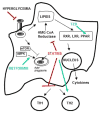New tricks for old dogs: countering antibiotic resistance in tuberculosis with host-directed therapeutics
- PMID: 25703571
- PMCID: PMC4571192
- DOI: 10.1111/imr.12255
New tricks for old dogs: countering antibiotic resistance in tuberculosis with host-directed therapeutics
Abstract
Despite the availability of Mycobacterium tuberculosis (Mtb) drugs for over 50 years, tuberculosis (TB) remains at pandemic levels. New drugs are urgently needed for resistant strains, shortening duration of treatment, and targeting different stages of the disease, especially for treatment during human immunodeficiency virus co-infection. One solution to the conundrum that antibiotics kill the bacillus yet select for resistance is to target the host rather than the pathogen. Here, we discuss recent progress in so-called 'host-directed therapeutics' (HDTs), focusing on two general mechanistic strategies: (i) HDTs that disrupt Mtb pathogenesis in macrophages and (ii) immunomodulatory HDTs that facilitate protective immune responses that kill Mtb or reduce deleterious responses that exacerbate disease. HDTs hold significant promise as adjunctive therapies in that they are less likely to engender resistance, will likely have efficacy against antibiotic-resistant strains, and may have activity against non-replicating Mtb. However, TB is a complex and variegated disease, and human populations exhibit significant diversity in their immune responses to it, which presents a complicated landscape for HDTs to navigate. Nevertheless, we suggest that a detailed mechanistic understanding of drug action, together with careful selection of disease stage targets and dosing strategies may overcome such limitations and allow the development of HDTs as effective adjunctive treatment options for TB.
Keywords: drug; innate immunity; macrophage; tuberculosis.
© 2015 John Wiley & Sons A/S. Published by John Wiley & Sons Ltd.
Conflict of interest statement
T. R. H., J. A. S., and D. K. have no conflicts of interest.
Figures





Similar articles
-
Host-directed therapy targeting the Mycobacterium tuberculosis granuloma: a review.Semin Immunopathol. 2016 Mar;38(2):167-83. doi: 10.1007/s00281-015-0537-x. Epub 2015 Oct 28. Semin Immunopathol. 2016. PMID: 26510950 Free PMC article. Review.
-
Host-Directed Therapeutic for the treatment of Mycobacterium tuberculosis.Microbiol Res. 2025 Oct;299:128253. doi: 10.1016/j.micres.2025.128253. Epub 2025 May 31. Microbiol Res. 2025. PMID: 40483737 Review.
-
Host-Directed Therapeutics as a Novel Approach for Tuberculosis Treatment.J Microbiol Biotechnol. 2017 Sep 28;27(9):1549-1558. doi: 10.4014/jmb.1705.05032. J Microbiol Biotechnol. 2017. PMID: 28683527 Review.
-
Host Directed Therapies for Tuberculosis: Futures Strategies for an Ancient Disease.Chemotherapy. 2018;63(3):172-180. doi: 10.1159/000490478. Epub 2018 Jul 20. Chemotherapy. 2018. PMID: 30032143 Review.
-
Host-directed therapies for tuberculosis: quantitative systems pharmacology approaches.Trends Pharmacol Sci. 2022 Apr;43(4):293-304. doi: 10.1016/j.tips.2021.11.016. Epub 2021 Dec 13. Trends Pharmacol Sci. 2022. PMID: 34916092 Review.
Cited by
-
What can immunology contribute to the control of the world's leading cause of death from bacterial infection?Immunol Rev. 2015 Mar;264(1):2-5. doi: 10.1111/imr.12277. Immunol Rev. 2015. PMID: 25703548 Free PMC article.
-
Hit and lead criteria in drug discovery for infectious diseases of the developing world.Nat Rev Drug Discov. 2015 Nov;14(11):751-8. doi: 10.1038/nrd4683. Epub 2015 Oct 5. Nat Rev Drug Discov. 2015. PMID: 26435527 Review.
-
Anti-tuberculosis treatment strategies and drug development: challenges and priorities.Nat Rev Microbiol. 2022 Nov;20(11):685-701. doi: 10.1038/s41579-022-00731-y. Epub 2022 Apr 27. Nat Rev Microbiol. 2022. PMID: 35478222 Free PMC article. Review.
-
Troglitazone Reduction of Intracellular Mycobacterium tuberculosis Survival Via Macrophage Autophagy Through LKB1-AMPKα Signaling.J Infect Dis. 2025 Mar 17;231(3):e553-e565. doi: 10.1093/infdis/jiae523. J Infect Dis. 2025. PMID: 39450555 Free PMC article.
-
Host Immune-Metabolic Adaptations Upon Mycobacterial Infections and Associated Co-Morbidities.Front Immunol. 2021 Sep 23;12:747387. doi: 10.3389/fimmu.2021.747387. eCollection 2021. Front Immunol. 2021. PMID: 34630426 Free PMC article. Review.
References
-
- Organization WH. WHO Annual Report. 2013. Global Tuberculosis Report 2013; pp. 1–289.
-
- Ma M, et al. Toll-like receptors, tumor necrosis factor–α, and interleukin-10 gene polymorphisms in risk of pulmonary tuberculosis and disease severity. HIM. 2010:1005–1010. - PubMed
-
- Swimm A, Bommarius B, Reeves P, Sherman M, Kalman D. Complex kinase requirements for EPEC pedestal formation. Nat Cell Biol. 2004;6:795. author reply 795–796. - PubMed
Publication types
MeSH terms
Substances
Grants and funding
LinkOut - more resources
Full Text Sources
Other Literature Sources
Medical

